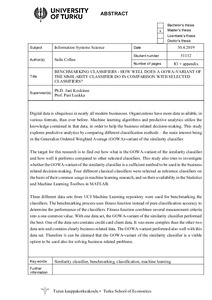BENCHMARKING CLASSIFIERS - HOW WELL DOES A GOWA-VARIANT OF THE SIMILARITY CLASSIFIER DO IN COMPARISON WITH SELECTED CLASSIFIERS?
Collan, Saila (2019-05-02)
BENCHMARKING CLASSIFIERS - HOW WELL DOES A GOWA-VARIANT OF THE SIMILARITY CLASSIFIER DO IN COMPARISON WITH SELECTED CLASSIFIERS?
Collan, Saila
(02.05.2019)
Julkaisu on tekijänoikeussäännösten alainen. Teosta voi lukea ja tulostaa henkilökohtaista käyttöä varten. Käyttö kaupallisiin tarkoituksiin on kielletty.
avoin
Julkaisun pysyvä osoite on:
https://urn.fi/URN:NBN:fi-fe2019050914995
https://urn.fi/URN:NBN:fi-fe2019050914995
Tiivistelmä
Digital data is ubiquitous in nearly all modern businesses. Organizations have more data available, in various formats, than ever before. Machine learning algorithms and predictive analytics utilize the knowledge contained in that data, in order to help the business related decision-making. This study explores predictive analytics by comparing different classification methods – the main interest being in the Generalize Ordered Weighted Average (GOWA)-variant of the similarity classifier.
The target for this research is to find out how what is the GOWA-variant of the similarity classifier and how well it performs compared to other selected classifiers. This study also tries to investigate whether the GOWA-variant of the similarity classifier is a sufficient method to be used in the busi-ness related decision-making. Four different classical classifiers were selected as reference classifiers on the basis of their common usage in machine learning research, and on their availability in the Sta-tistics and Machine Learning Toolbox in MATLAB.
Three different data sets from UCI Machine Learning repository were used for benchmarking the classifiers. The benchmarking process uses fitness function instead of pure classification accuracy to determine the performance of the classifiers. Fitness function combines several measurement criteria into a one common value. With one data set, the GOWA-variant of the similarity classifier per-formed the best. One of the data sets contains credit card client data. It was more complex than the other two data sets and contains clearly business related data. The GOWA-variant performed also well with this data set. Therefore it can be claimed that the GOWA-variant of the similarity classifi-er is a viable option to be used also for solving business related problems.
The target for this research is to find out how what is the GOWA-variant of the similarity classifier and how well it performs compared to other selected classifiers. This study also tries to investigate whether the GOWA-variant of the similarity classifier is a sufficient method to be used in the busi-ness related decision-making. Four different classical classifiers were selected as reference classifiers on the basis of their common usage in machine learning research, and on their availability in the Sta-tistics and Machine Learning Toolbox in MATLAB.
Three different data sets from UCI Machine Learning repository were used for benchmarking the classifiers. The benchmarking process uses fitness function instead of pure classification accuracy to determine the performance of the classifiers. Fitness function combines several measurement criteria into a one common value. With one data set, the GOWA-variant of the similarity classifier per-formed the best. One of the data sets contains credit card client data. It was more complex than the other two data sets and contains clearly business related data. The GOWA-variant performed also well with this data set. Therefore it can be claimed that the GOWA-variant of the similarity classifi-er is a viable option to be used also for solving business related problems.
